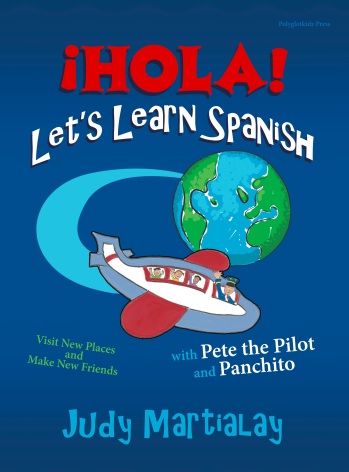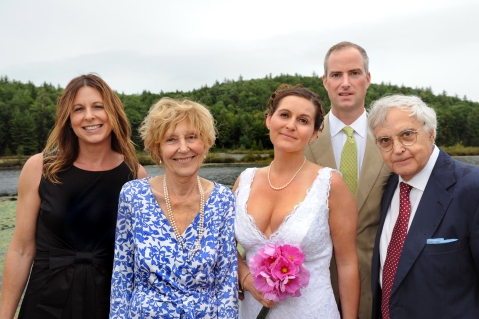
Happy Friday, amig@s! The weekend is here, and for me that means more time to READ! If you’re like me, always looking for a good book to read (both for yourself and for your children), then you’ll love today’s post.
Author and former language teacher, Judy Martialay, sent me a copy of her children’s book ¡Hola! Let’s Learn Spanish a few weeks ago, and the minute I got my hands on it, I knew I wanted to share it with you all.
Designed to introduce children between the ages of six and 11 to the Spanish language and Hispanic culture, this book would make a great addition to your home library. Here’s what I love about it:
- Child-focused and friendly – Although it’s meant to teach children basic Spanish words, phrases, and cultural knowledge, it’s written in a way that you, the parent, could simply give it to your child to read on her own. There are colorful illustrations, craft ideas, and a fun story of cultural exploration and adventure (meet Pete the Pilot and Panchito!).
- Designed for the non-native speaker of Spanish – I can already think of several non-native Spanish-speaking family friends of mine who I’d love to pass this book on to, families that are eager to expose their children to introductory Spanish. I would feel totally comfortable giving this book to these parents (who don’t speak the language themselves) because it presents the language in a natural and non-threatening way. For example, the story about Pete the Pilot and Panchito is written in 90% English with one or two Spanish words sprinkled throughout each paragraph.
- Culturally sensitive – It’s clear that Judy took her time to research México, the culture highlighted in the book. There is a section entitled Rincón Cultural, in which she explains in clear, child-friendly language the type of Spanish used, typical food, customs, and celebrations.
And, of course, behind every book is an author. Judy graciously agreed to tell us a bit about her professional background, experience raising bilingual children, and why she believes every child should learn a second language.
Read on, amig@s, and be encouraged!

Can you tell my readers a bit about your professional background, as it relates to learning and teaching languages?
I graduated from Mount Holyoke College, BA, majoring in French, with minors in Spanish and Italian. I have an MA in French from Columbia School of Arts and Science. I started teaching elementary school to children in a boy’s school in the lovely and historic town of Arles, in Provence, southern France. I spent the next year giving English conversation in a girls’ Cours Complémentaire in Toulouse.
In the United States, I started teaching foreign language in elementary school (FLES), then I taught Junior High and High School in Bethpage, N.Y. I taught Spanish, French, and at one point Italian. When I retired, I became Chair of the Public Advocacy Committee of the New York State Association of Foreign Language Teachers. We lobbied in Albany and Washington for bills supporting language study. We connected with parents and businesspeople. I’m still active in public advocacy.

On your website it states that your “…dream is to give all children the opportunity to experience a foreign language.” Can you talk to us about where this dream came from? Why is learning a foreign language so important for children?
From birth, children have the unique ability to hear and reproduce any sound made in any human language. That ability generally disappears by age 12. So. children can acquire native pronunciation if they start to study a language early. Also, it is easier for them to learn the language. It is thought that the patterns of speech of their native language aren’t so deeply ingrained, and they are more receptive to different ways of thinking. They have more years to master the complexities of another language. Adults can learn a language, but they usually don’t have the time necessary to learn the language well enough to become proficient.
There are many mental benefits to learning another language; for language students, these advantages carry over to other subjects. They include greater cognitive ability, better thinking skills, improved memory, greater mastery of their own language, higher verbal skills, more tolerance for diversity, more respect for other cultures, and better appreciation of their own culture. They can communicate directly with millions more people, and have better opportunities for employment. Because of the development of mental capacity, the onset of dementia in bilingual people can be delayed by up to five years.
Most students in the U.S. don’t begin to study a language until age 14, if at all. Compared to about twenty countries with highly developed economies, our students start at the oldest age. They usually take two years on the average, which is not enough time to become fluent in a language or to master any subject.
When I started teaching, a long time ago, the U.S. was afraid that the Soviet Union was surpassing us in science, technology, and in the space race, and there was a big effort for our students to study more math, science and foreign language. Many schools began programs of foreign language in elementary school. As the years went by, we became complacent, and declared that “the whole world speaks English.” The truth is that 75% of the world neither speaks nor understands English. FLES programs were cut. They were the first to be eliminated during the recent economic downturn. Today, only 15% of elementary schools offer any kind of foreign language programs.
I watched as our counterparts around the world gradually lowered the age at which almost all their students began study of another language. They seemed to realize that “you buy in your own language, but you sell in your customer’s language.”
Nowadays, as our world is becoming ever more global, our students are not prepared for the competition. Besides, they are missing out on the enrichment, the international connections, and the life-transforming experience that knowing another language brings.
I want our children to have the same opportunities as their international peers.

You’re a native English speaker married to a Spaniard. Did you raise your daughters bilingually? Can you paint a picture for us of your family’s language experience?
My two daughters, who are now in their 40’s, were born in northern Spain. We couldn’t afford the hospital bills in the U.S., so we went to Spain to live with my husband’s parents. We lived there for a few months before and after the births. Our older daughter was almost three years old when the younger one was born. By the time we returned to the U.S., she had forgotten all her English; she spoke only Spanish. At the time, the benefits of being bilingual weren’t clear, and it was commonly thought that learning two languages could confuse the child. Still, we spoke Spanish at home often, and I read to the children in Spanish. Little by little, the older child changed her talking from Spanish to English. Since her friends and relatives spoke English, she felt more comfortable speaking English. However, she still speaks Spanish with a perfect accent. She spent a college semester in Salamanca, Spain, and had an internship in a Spanish law firm in Madrid. She is a lawyer in a law firm that has many clients in Mexico.
My younger daughter was a rebel; she didn’t want to speak Spanish until, during a trip to Spain, she discovered that no one would tell her where the bathroom was unless she asked in Spanish! As she became older, she realized the value of knowing Spanish. She spent time with her cousins in Spain, and spent a college semester in Bilbao, Spain. She had an internship in journalism in Costa Rica. She is making big efforts so that her 20-month daughter will be bilingual. She has an au pair girl from Colombia, who speaks to the baby in Spanish, and has many books in Spanish for children.
Tell us a bit about your book Hola! Let’s Learn Spanish:
- Why write a book?
- Who is the intended audience (age, demographic)?
- What do you hope to accomplish with this book? Or, what’s the goal of the book?
Writing the book was the outcome of my years doing public advocacy for foreign languages in New York State. My experience of attending public hearings on education taught me that we need the support of parents in order to increase programs of foreign language classes in elementary school. I wanted to find a way to get parents and kids enthusiastic about learning a new language. Since there are so few existing FLES classes, I needed to find a way that parents themselves could take the initiative to start their children learning languages at an early age. The book was the answer.
The book is for children ages 6-10, but maybe younger and older children can enjoy it. ¡HOLA! is unique in that it starts with a story: children go on an imaginary trip, they follow the adventures of Panchito, the Mexican Jumping Bean as they learn Spanish and are introduced to the culture of Mexico. When they come back home they can practice Spanish with friends and family. The activities are varied and this favors children with different styles of learning: speaking, listening, singing, making a mask. Children are physically engaged during activities such as the treasure hunt and trip to the supermarket. In the skit, they act out the actions in their lines as they say them. Children learn best when they are having fun, and I hope that they will enjoy the book.
By the way, I am working on a book for French, and books for other languages in coming years.

What is your favorite part of knowing/learning another language?
I have many favorite parts; I think that knowing another language is fun and it’s an adventure. Using the language is like going to outer space; you are discovering a new world. Knowing another language gives you the tool to explore another culture on your own. Other countries have not only beautiful monuments, colorful customs, holidays, music and celebrations; they have their own history, their own government, their own literature. We share our common humanity, and we have much in common, but other cultures have found different approaches to the issues of the human condition, and we have much to learn from one another.
One of the aspects of international travel that we don’t often think about is this: we are, each one of us, an ambassador for our country. We have the opportunity to explain our culture, to correct misconceptions, to combat stereotypes, to exchange ideas, to make friends and to create good will. We can be much more effective in doing this if we can speak the language of the country we are visiting.
In the U.S., we live in our huge, great country. We are a continent, a world unto ourselves, sort of isolated from the rest of the world. Have you noticed that almost everything from abroad comes to us filtered in English? Unlike other countries, where subtitles are used, voices in foreign languages are dubbed in English. Something is lost in the translation!
When I lived abroad after college, it dawned on me that the U.S. is not the center of the world for people living in other countries. Of course, they follow news events, and especially music from the U.S. with great attention, but they have their own lives, their own worries, problems, their own culture and their own opinions. It was a revelation to me, and it can be applied to all people: others have their own thoughts, interests and priorities, and we must respect, value and appreciate the differences and similarities. It’s an important lesson of life.
Gracias, Judy, for stopping by the blog!
















